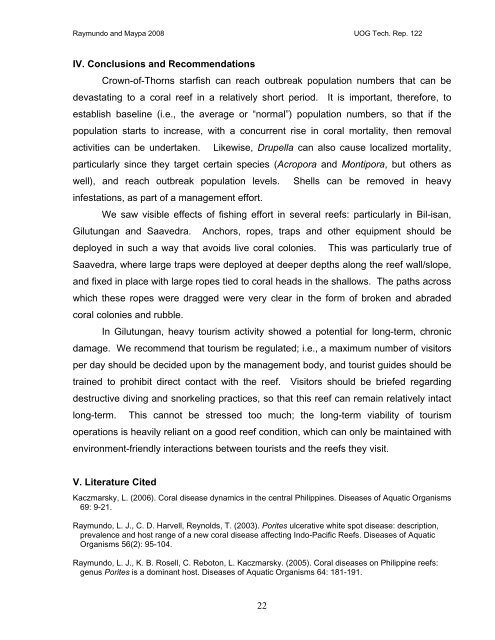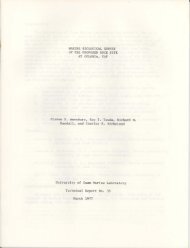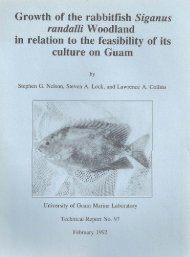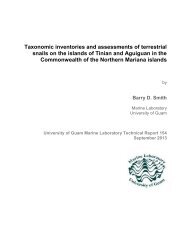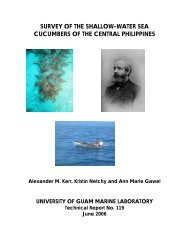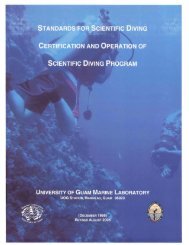Marine Protected Area Surveys Central Visayas, Philippines 2007
Marine Protected Area Surveys Central Visayas, Philippines 2007
Marine Protected Area Surveys Central Visayas, Philippines 2007
Create successful ePaper yourself
Turn your PDF publications into a flip-book with our unique Google optimized e-Paper software.
Raymundo and Maypa 2008 UOG Tech. Rep. 122<br />
IV. Conclusions and Recommendations<br />
Crown-of-Thorns starfish can reach outbreak population numbers that can be<br />
devastating to a coral reef in a relatively short period. It is important, therefore, to<br />
establish baseline (i.e., the average or “normal”) population numbers, so that if the<br />
population starts to increase, with a concurrent rise in coral mortality, then removal<br />
activities can be undertaken. Likewise, Drupella can also cause localized mortality,<br />
particularly since they target certain species (Acropora and Montipora, but others as<br />
well), and reach outbreak population levels. Shells can be removed in heavy<br />
infestations, as part of a management effort.<br />
We saw visible effects of fishing effort in several reefs: particularly in Bil-isan,<br />
Gilutungan and Saavedra. Anchors, ropes, traps and other equipment should be<br />
deployed in such a way that avoids live coral colonies. This was particularly true of<br />
Saavedra, where large traps were deployed at deeper depths along the reef wall/slope,<br />
and fixed in place with large ropes tied to coral heads in the shallows. The paths across<br />
which these ropes were dragged were very clear in the form of broken and abraded<br />
coral colonies and rubble.<br />
In Gilutungan, heavy tourism activity showed a potential for long-term, chronic<br />
damage. We recommend that tourism be regulated; i.e., a maximum number of visitors<br />
per day should be decided upon by the management body, and tourist guides should be<br />
trained to prohibit direct contact with the reef. Visitors should be briefed regarding<br />
destructive diving and snorkeling practices, so that this reef can remain relatively intact<br />
long-term. This cannot be stressed too much; the long-term viability of tourism<br />
operations is heavily reliant on a good reef condition, which can only be maintained with<br />
environment-friendly interactions between tourists and the reefs they visit.<br />
V. Literature Cited<br />
Kaczmarsky, L. (2006). Coral disease dynamics in the central <strong>Philippines</strong>. Diseases of Aquatic Organisms<br />
69: 9-21.<br />
Raymundo, L. J., C. D. Harvell, Reynolds, T. (2003). Porites ulcerative white spot disease: description,<br />
prevalence and host range of a new coral disease affecting Indo-Pacific Reefs. Diseases of Aquatic<br />
Organisms 56(2): 95-104.<br />
Raymundo, L. J., K. B. Rosell, C. Reboton, L. Kaczmarsky. (2005). Coral diseases on Philippine reefs:<br />
genus Porites is a dominant host. Diseases of Aquatic Organisms 64: 181-191.<br />
22


